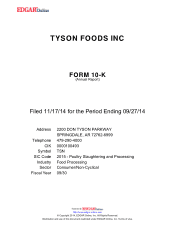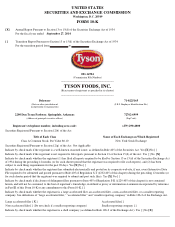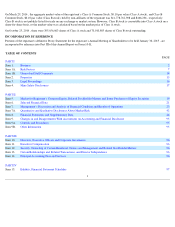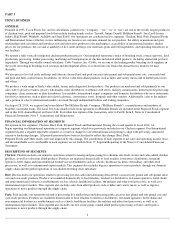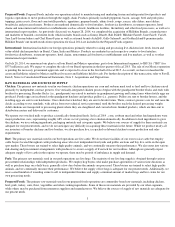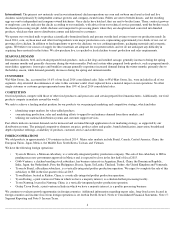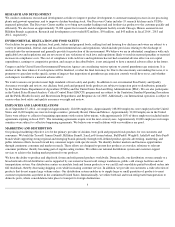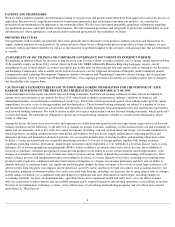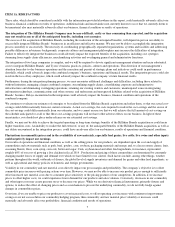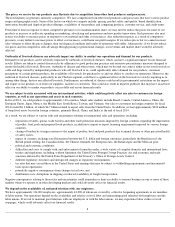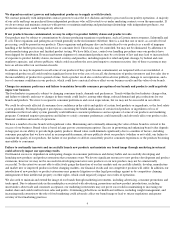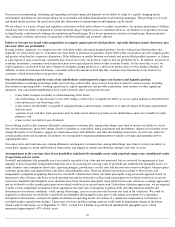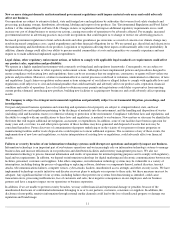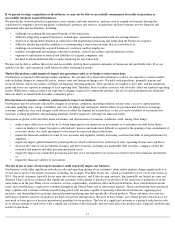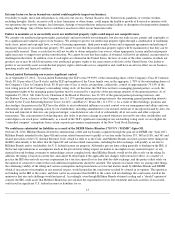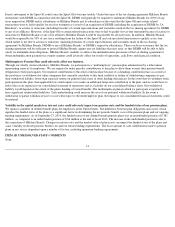Tyson Foods 2014 Annual Report Download - page 6
Download and view the complete annual report
Please find page 6 of the 2014 Tyson Foods annual report below. You can navigate through the pages in the report by either clicking on the pages listed below, or by using the keyword search tool below to find specific information within the annual report.
International: The primary raw materials used in our international chicken operations are corn and soybean meal used as feed and live
chickens raised primarily by independent contract growers and company-owned farms. Pullets are sent to breeder houses, and the resulting
eggs are sent to independent and company-owned hatcheries. Once chicks have hatched, they are sent to broiler farms. There, contract growers
or employees care for and raise the chicks according to our standards, with advice from our technical service personnel, until the broilers reach
the desired processing weight. Adult chickens are transported to processing plants where they are slaughtered and converted into finished
products, which are then sent to distribution centers and delivered to customers.
We operate our own feed mills to produce scientifically-formulated feeds and procure outside feed at times to meet our production needs. In
fiscal 2014, corn, soybean meal and other feed ingredients were major production costs, representing approximately two-thirds of our cost of
growing a live chicken. In addition to feed ingredients to grow the chickens, we use cooking ingredients, packaging materials and cryogenic
agents. We believe our sources of supply for these materials are adequate for our present needs, and we do not anticipate any difficulty in
acquiring these materials in the future. We also purchase live, ice-packed or fresh chicken to meet production and sales requirements.
SEASONAL DEMAND
Demand for chicken, beef, and certain prepared foods products, such as hot dogs and smoked sausage, generally increases during the spring
and summer months and generally decreases during the winter months. Pork and certain other prepared foods products, such as prepared meals,
meat dishes, appetizers, frozen pies and breakfast sausage generally experience increased demand during the winter months, primarily due to
the holiday season, while demand generally decreases during the spring and summer months.
CUSTOMERS
Wal-Mart Stores, Inc. accounted for 14.6% of our fiscal 2014 consolidated sales. Sales to Wal-Mart Stores, Inc. were included in all of our
segments. Any extended discontinuance of sales to this customer could, if not replaced, have a material impact on our operations. No other
single customer or customer group represented more than 10% of fiscal 2014 consolidated sales.
COMPETITION
Our food products compete with those of other food producers and processors and certain prepared food manufacturers. Additionally, our food
products compete in markets around the world.
We seek to achieve a leading market position for our products via our principal marketing and competitive strategy, which includes:
Past efforts indicate customer demand can be increased and sustained through application of our marketing strategy, as supported by our
distribution systems. The principal competitive elements are price, product safety and quality, brand identification, innovation, breadth and
depth of product offerings, availability of products, customer service and credit terms.
FOREIGN OPERATIONS
We sold products in approximately 130 countries in fiscal 2014 . Major sales markets include Brazil, Canada, Central America, China, the
European Union, Japan, Mexico, the Middle East, South Korea, Taiwan, and Vietnam.
We have the following foreign operations:
We continue to evaluate growth opportunities in foreign countries. Additional information regarding export sales, long-lived assets located in
foreign countries and income (loss) from foreign operations is set forth in Part II, Item 8, Notes to Consolidated Financial Statements, Note 17:
Segment Reporting and Note 9: Income Taxes.
4
• identifying target markets for value-
added products;
•
concentrating production, sales and marketing efforts to appeal to and enhance demand from those markets; and
•
utilizing our national distribution systems and customer support services.
• Tyson de Mexico, a Mexican subsidiary, is a vertically-integrated poultry production company. The sale of this subsidiary to JBS is
pending necessary government approvals in Mexico and is expected to close in the first half of fiscal 2015.
• Cobb-Vantress, a chicken breeding stock subsidiary, has business interests in Argentina, Brazil, China, the Dominican Republic,
India, Japan, the Netherlands, Peru, the Philippines, Russia, Spain, Sri Lanka, Thailand, Turkey, the United Kingdom and Venezuela.
• Tyson do Brazil, a Brazilian subsidiary, is a vertically-integrated poultry production operation. We expect to complete the sale of this
subsidiary to JBS in the first quarter of fiscal 2015.
• Tyson Rizhao, located in Rizhao, China, is a vertically-
integrated poultry production operation.
•
Tyson Dalong, a joint venture in China in which we have a majority interest, is a chicken further processing facility.
• Tyson Nantong, located in Nantong, China, is a vertically-
integrated poultry production operation.
•
Godrej Tyson Foods, a joint venture in India in which we have a majority interest, is a poultry processing business.

